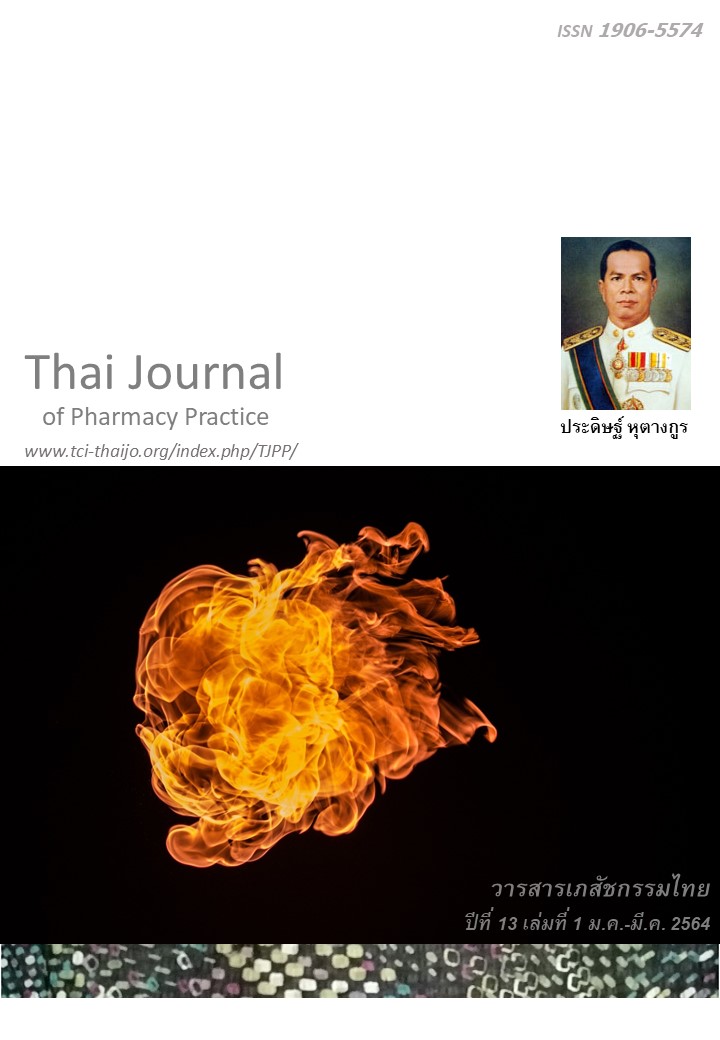การพัฒนาระบบการสั่งใช้ยาปฏิชีวนะเพื่อการใช้ยาอย่างสมเหตุผล: กรณีศึกษาโรคติดเชื้อระบบ ทางเดินหายใจและบาดแผลสดจากอุบัติเหตุของโรงพยาบาลชุมชนแห่งหนึ่งในภาคเหนือตอนบน
Main Article Content
บทคัดย่อ
วัตถุประสงค์: 1) หาปัจจัยที่ส่งผลต่อพฤติกรรมการสั่งใช้ยาปฏิชีวนะของแพทย์ในโรคติดเชื้อระบบทางเดินหายใจและบาดแผลสดจากอุบัติเหตุ 2) พัฒนาระบบการสั่งใช้ยาปฏิชีวนะอย่างสมเหตุผล และ 3) ประเมินผลสัมฤทธิ์ระบบการสั่งใช้ยาปฏิชีวนะอย่างสมเหตุผล วิธีการ: การศึกษานี้เป็นงานวิจัยกึ่งทดลองในตัวอย่างหนึ่งกลุ่มแบบวัดผลก่อนและหลังการแทรกแซง งานวิจัยแบ่งเป็น 3 ระยะ ได้แก่ 1) การหาปัจจัยที่มีผลต่อการสั่งใช้ยาปฏิชีวนะในโรคติดเชื้อระบบทางเดินหายใจและบาดแผลสดจากอุบัติเหตุโดยวิธีการสนทนากลุ่มในกลุ่มสหวิชาชีพ แพทย์ เภสัชกร และพยาบาล 2) การพัฒนาระบบการสั่งใช้ยาปฏิชีวนะด้วยการประยุกต์ใช้วงจรวิจัยเชิงปฏิบัติการมาพัฒนาระบบ โดยการสนทนากลุ่มในคณะกรรมการเภสัชกรรมและการบำบัด (PTC) และ 3) การประเมินผลสัมฤทธิ์ของระบบก่อน-หลังการนำระบบการสั่งใช้ยาปฏิชีวนะมาใช้ในโรงพยาบาลเป็นเวลา 4 เดือนในด้านมูลค่า ปริมาณการสั่งใช้ยา และแบบแผนการสั่งใช้ยาปฏิชีวนะของแพทย์ ผลการวิจัย: ปัจจัยที่ส่งผลต่อพฤติกรรมการสั่งใช้ยาปฏิชีวนะของแพทย์ ประกอบด้วย 1. ปัจจัยนำ ได้แก่ ความรู้ ประสบการณ์ ความเคยชิน และความเชื่อของแพทย์ผู้สั่งใช้ยา 2. ปัจจัยเสริม ได้แก่ การร้องขอจากผู้ป่วยและผู้นำ 3. ปัจจัยเอื้อ ได้แก่ กรอบบัญชียา กุญแจสำคัญ 6 ประการ (PLEASE) และการสื่อสาร จนนำไปสู่การวางแผนพัฒนาระบบการสั่งใช้ยาปฏิชีวนะร่วมกัน ดังนี้ การกำหนดเป้าหมายชัดเจนจากผู้อำนวยการโรงพยาบาล แนวทางการสั่งใช้ยาของแพทย์ แนวทางในการจ่ายยา การเพิ่มช่องทางในการสื่อสารระหว่างแพทย์และเภสัชกร และติดตามผลอย่างต่อเนื่องโดย PTC การพัฒนาระบบทำให้เกิดผลสัมฤทธิ์ดังนี้ อัตราการใช้ยาปฏิชีวนะเฉลี่ยลดลงร้อยละ 18.85 ในโรคติดเชื่อทางเดินหายใจส่วนบนและร้อยละ 40.38 ในแผลสด มูลค่าการใช้ยาปฏิชีวนะลดลงจากเดิมจำนวน 21,228 บาท คิดเป็นร้อยละ 51.84 สรุป: การวิเคราะห์ปัญหาและร่วมกันพัฒนาระบบการสั่งใช้ยาปฏิชีวนะอย่างสมเหตุผลในระหว่างกลุ่มสหสาขาวิชาชีพ โดยมีปัจจัยสนับสนุนทั้งด้านปัจจัยนำ ปัจจัยเสริม และปัจจัยเอื้อที่เหมาะสมกับบริบทของโรงพยาบาล ส่งผลให้เกิดการใช้ยาปฏิชีวนะสมเหตุผลมากขึ้น
Article Details
ผลการวิจัยและความคิดเห็นที่ปรากฏในบทความถือเป็นความคิดเห็นและอยู่ในความรับผิดชอบของผู้นิพนธ์ มิใช่ความเห็นหรือความรับผิดชอบของกองบรรณาธิการ หรือคณะเภสัชศาสตร์ มหาวิทยาลัยสงขลานครินทร์ ทั้งนี้ไม่รวมความผิดพลาดอันเกิดจากการพิมพ์ บทความที่ได้รับการเผยแพร่โดยวารสารเภสัชกรรมไทยถือเป็นสิทธิ์ของวารสารฯ
เอกสารอ้างอิง
Holloway KA. Promoting the rational use of anti- biotics. Reg Health Forum 2011;15: 112-30.
World Health Organization. Promoting rational use of medicines: core components [online]. 2002 [cited Nov 30, 2018]. Available from: apps.who.int/iris/hand le/10665/67438.
Suttajit S, Sumpradit N, Hunnangkul S, Prakongsai Ph, Thamlikitkul V. Hospital Infection Control and Antimicrobial Stewardship Programs among Public and Private Hospitals in Thailand. Journal of Health Systems Research 2013; 7:281-95.
Chudpradit N, Poonphonsap S, Suthachit S, Chuan chuen R, Prakhonsai P. Landscape of antimicrobial resistance situation and action in Thailand. Bangkok: Graphic and Design publisher; 2015. p.17-34.
Thamlikitkul V, Rattanaumpawan P, Boonyasiri A, Siri jatuphat R, Jaroenpoj S. Operational actions of the Thailand Antimicrobial Resistance (AMR) contain ment and prevention program in response to the World Health Organization (WHO) global action plan on AMR. Journal of Health Systems Research 2017; 11: 453-70.
Chaiyasong C, Tiyapak P, Pinake S, Chaiyasong S. Associations between Antibiotic Use and Resistance in Mahasarakham Hospital. Isan Journal of Pharma ceutical Sciences 2019; 15: 98-105.
Chongtrakul P. RDU hospital: The pathway to rational drug use. Thai Journal of Pharmacology. 2015; 37: 48-62.
Health Administration Division. Report on the develop ment of service systems for reasonable drug use [online]. 2019 [cited Nov 30, 2018]. Available from: 203.157.3.54/hssd1/umd/HSS_RDU/production/home/login.php.
Chankhunaphat P, Bunyarit P, Srisuphan W, Prapaso N, Lueangruangrong P. Service plan: Rational drug use. Nonthaburi: Ministry of Public Health; 2017.
Crosby R, Noar SM. What is a planning model? An introduction to PRECEDE‐PROCEED. J public health Dent 2011; 71: S7-15.
Sampradit N, Tangkaew W, Asawakitwire W, Chong trakul P, Anuwong K, Poomthong S, et al. Educa tional expanding the Antibiotic Smart Use project. Nonthaburi: Ministry of Public Health and Health System Research Institute; 2009.
Limwattananon C, Sooksai N, Toparkgarm A, Walee khachonloet A, Kitwiti P, Rattanachotphanit T, et al. Measures to promote rational use of medicines in public hospitals: a review and analysis of national policy interventions. Journal of Health Systems Research 2013; 7: 33-44.
Amanda LG, Hans VH, Flora M HR. Intervention research in rational use of drugs: a review. Health Pol Plan 1999;14: 89-102.
Ruangrong J, Thirawatanon Y, Chaloelkaew U, TantiWess S. Study of interventions and strategies to improve the use of antimicrobials in hospitals in thailand. Nonthaburi: Health Insurance System Research Office; 2009.
Bbosal GS, Wong G, Kyegombe DB, Ogwal-Okeng J. Effects of intervention measures on irrational antibiotics/antibacterial drug use in developing coun tries: A systematic review. Health 2014; 6(2): 171-87.
Sriviriyanupap W, Muenpa R. Outcomes of pharma ceutical care services in promoting rational drug use. Thai J Pharm Sci 2016; 40: 95-101.
Basaran NF, Akici A. Aspects of physicians’ attitudes towards the rational use of drugs at a training and research hospital: a survey study. Eur J Clin Pharmacol 2013; 69: 1581-7.
Anuwong K, Poomthong S, Chiamcharaschod P. Assessing the pilot project Promoting Reasonable Antibiotics Smart Use in Saraburi Province. Nontha buri: Ministry of Public Health and World Health Organization; 2008.


